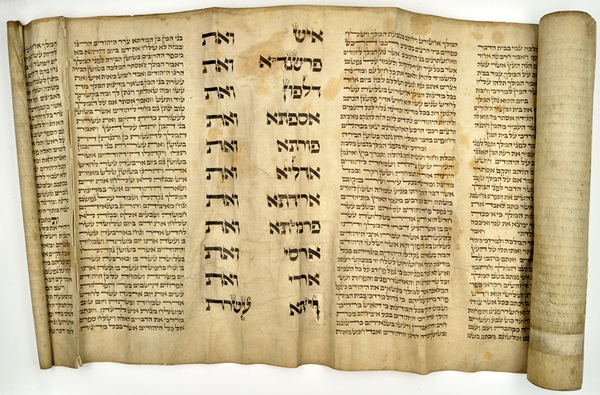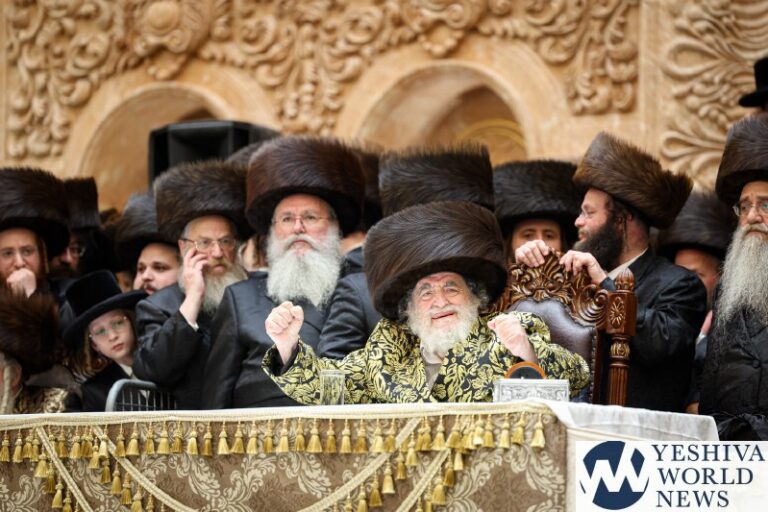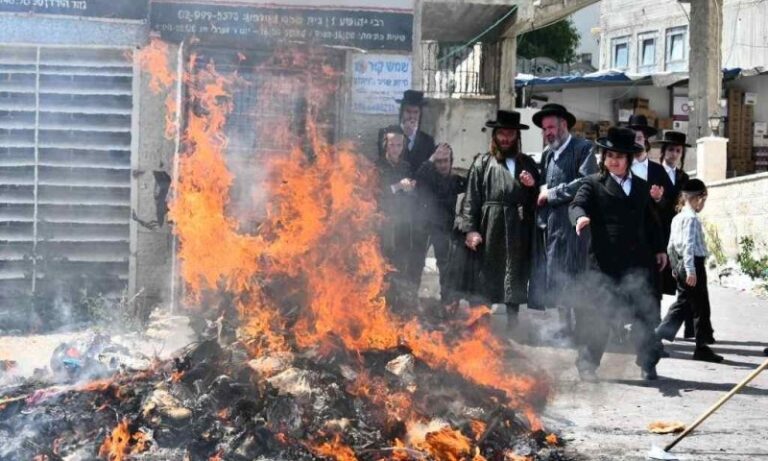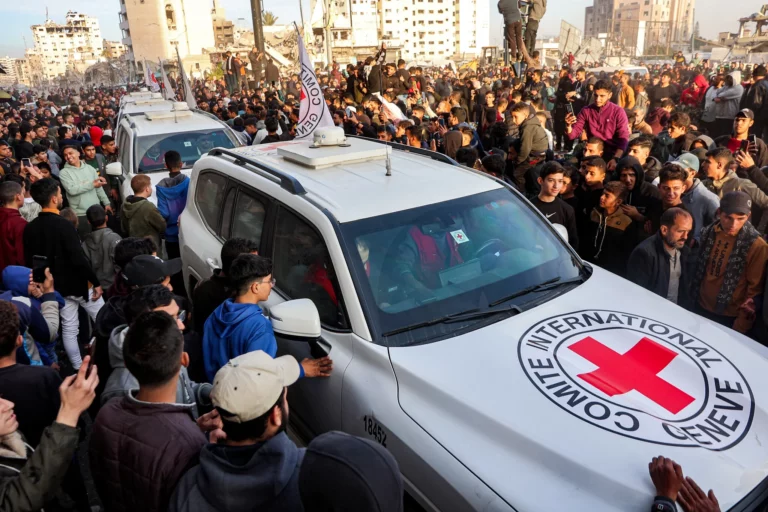By Rabbi Yair Hoffman for 5tjt.com
- The obligation is to read the Megillah at night and in the day in commemoration of the miracle, where they cried out day and night. The daytime reading begins at sunrise and continues until the end of the day. If it was read from Amud HaShachar – dawn, the Mitzvah has still been fulfilled. It is interesting to note that the Mishna does not mentione the night reading at all.
- The reader must read the Megillah as if it was an iggeres – a letter. Therefore, he should not pause between the Psukim more than a breath. This is the ruling of the Tur and the Mogain Avrohom.
- The chapter splits of Megilas Esther are NOT OF JEWISH ORIGIN. Therefore, it is wrong for the reader to end off a chapter with a different tone or melody. (Kuntrus Toras HaKoreh).
- The nighttime reading begins when three stars come out and continues throughout the night until 1 and 1/5th hours before sunrise.
- If one lives far away and can only travel to hear one reading of the Megillah, it is preferable to hear the day reading rather than the night reading.
- If it is absolutely impossible to hear the Megillah otherwise, and one cannot read the Megillah by oneself, may one fulfill the obligation by telephone? Rav Moshe Feinstein zt”l (IM OC IV 91:4) permitted a woman to hear Havdallah in a hospital through the telephone if there was no other possibility. Rav Shlomo Zalman Auerbach (Minchas Shlomo Vol. I #9) disagreed but did hear a ruling from the Chazon Ish that it is not so simple to dismiss this possibility. Some Poskim therefore rule that when there is no other choice at all, one should opt for the telephone option.
- The most preferred manner of fulfilling the Mitzvah is to read the Megillah publicly, and in the Synagogue. When attending the Megillah in a bigger place one should have in mind that he or she is giving greater glory to Hashem by hearing the Megillah there. This Kavannah serves to bring us closer to Hashem, and is an action similar in purpose to the recitation of Kaddish, an extremely holy endeavor.
Pirsumei Nissah
8. Reading the Megillah involves the notion of Pirsumei Nissah – publicizing the miracle. Because of this, it sets aside any other Mitzvah – even a Torah Mitzvah. Even the study of the Torah is set aside for the reading of the Megillah. The only Mitzvah which is not pushed off is the Mitzvah of providing burial for a dead person, when there is no one else available to do so. This is interesting because reading the Megillah is only a Rabbinic Mitzvah. If the other Mitzvah cannot be performed later, however, and it is a Biblical Mitzvah – that Mitzvah would come first. A Bris Milah is an exception to this halacha. The Bris Milah is performed before the reading of the Megillah.
9. Even if there are many people in one’s company, he should not read the Megillah at home, but should rather go to the Synagogue, since, ‘In a multitude there is Majesty;’ and the miracle is made known more widely.
The Brachos on the Megillah
10. Before reading it, the reader of the Megillah recites these three blessings:
- “Al Mikrah Megillah” – Who sanctified us with His commandments, and commanded us with the Reading of the Megillah
- “Sh’asah nissim laAvosainu,” – Who made miracles for our fathers in those days at this time…
- “Shehecheyanu.” – Who kept us alive and sustained us…
After the reading he recites the blessing of “Harav es riveinu” – Who waged our quarrels…
11. The reader should intend to fulfill the obligation of the congregation. The congregation answers ‘Amen,’ and they too should intend to fulfill the Mitzvah. “Baruch Hu u’varuch Sh’mo’ – is not said.
12. The only difference between the day reading and the night reading is that in the day when saying “Shehecheyanu” the Reader should have in mind the other Mitzvos of the day – the Purim Feast, the Sending of Gifts, and possibly Matanos L’Evyonim – Giving of Gifts to the Poor. Some leave out the last one possibly because it may be improper to recite a blessing on someone’s misfortune.
13. If someone read it without having recited the blessings he has still fulfilled the Mitzvah. If a person remembered that the blessings were not recited, they may be recited in between the chapters of the Megillah.
14. If one reads the Megillah alone, he recites the “brachos” which come before it, but not the one which comes after. If one has already fulfilled the obligation of reading the Megillah, and he wishes to read it a second time for many other people, he recites all the “brachos” the beginning ones and the end bracha.
15. If he is reading the Megillah only for one other individual, he recites only the first brachos. If that person knows the brachos well, he says them himself.
16. Before HaRav es Riveinu – the final brachah after the Megillah Reading, the Megillah is rolled together. This is because it is disrespectful to keep the Megillah open after the reading.
Aspects of the Megillah
17. In (1:7) it is the custom to recite the words “Vechailim mikailim shonim” to the tune of Aicha. The reason is because it refers to Achashveirosh’s use of the vessels of the Temple for a mundane use. We do not do this, however, when we read “v’es y’kar tiferes gdulaso” even though the Gemorah tells us that he wore the vestments of the Kohain Gadol at this time. The reason is because during the latter he did not mean to show disrespect to the clothing, but he did mean to do so for the vessels.
18. The Baal Koreh stops and waits for the Kahal four times during the reading. Where is this done? It is done during the four “verses-of-redemption.” After he stops everyone listening reads the Pasuk before him. The Chazan then repeats it from his Megillah. This is because all the listeners are required to hear the entire Megillah read.
19. These are the four Psukim where he stops: “Ish Yehudi haya beshushan habirah – There was a Jew in Shushan the capital…’ ’And Mordechai went forth from before the King in royal garments…’ ’Unto the Jews there was light…’ ’For Mordechai, the Jew, was second to the King. . .’
20. The purpose of this custom is to keep the children from slumber so that the great miracle performed for Israel in the days of Mordechai and Esther, might enter their hearts.
21. Another minhag is to read more loudly the Pasuk which states, “That night the sleep of the King was disturbed.” It is also read in a slightly different tune. These changes are made because it is in this particular pasuk in which the salvation of the Jews actually begins. According to the Kaballah, “the King” refers metaphorically to Hashem Himself.
22. We also read the names of the ten sons of Haman all together in one breath. This is also done with the four preceding words [‘500 men and’], and the word ‘ten’ which follows the ten names. This is done to show that they were all killed and hung together. If this was not done the Mitzvah of reading has still been fulfilled.
23. The reader should be careful not to read the “v’es” of each son of Haman by heart. He must read it from the Megillah. Likewise he should connect each “v’es” to the one that comes before the name and not after the name.
24. Rav Michel Ber Weismandel zatzal, after the horrors of the Second World War, made a remarkable discovery in the letters of the Megillah itself. In the writing of the ten sons of Haman Megillah (9:7-9), there are three letters, the Taf, the Shin, and the Zayin, of a much smaller size than the other letters of the Megillah. These letters correspond to 5707 – the Hebrew year that occurred during the 1946 hangings that resulted after the Nuremburg Trials. Ten “sons of Haman” were hung during this period. No other adequate explanation has ever been given to explain the different sizes of the letters in this section. There is also a very large Hey in this section which corresponds to the fifth millennium (5000 plus 707).
25. It is interesting to note that Esther says in the Megillah, “Im al haMelech Tov, yinasain gam lamachar.. v’es aseres Bnei Haman.. – If it is pleasing to the King, He should also give tomorrow – the ten sons of Haman. As mentioned before the Kaballah states that whenever the word HaMelech appears in the Megillah, it also refers metaphorically to Hashem. It is also interesting to note that Newsweek magazine reported that Julius Streicher, Yimach Shmo, one of ten Nazis hung at Nuremberg said while going to the gallows, the words “Purimfest, 1946!
26. All are obligated in reading the Megillah: Men, women, converts, and children. The term “reading the Megillah” is used instead of “hearing the Megillah” for a reason. The obligation, however, is to hear it from someone who is himself obligated in reading it too.
26 1/2. Contrary to popular belief there is no obligation to pull pra
MATANOS L’Evyonim Please give to a very worthwhile young couple in need of help
The author can be reached at [email protected]












9 Responses
Actually the Congregation reads at 5 places, since Congregation also reads aloud the 10 sons ahead of בעל-קורא who cannot be מוציא anyone else’s “in 1 breath”
In morning, שהחינו is not recited, and only first 2 ברכות prior to reading of מגילה
If Chapters are OF NON JEWISH ORIGIN, why can you make the Brachos between chapters? Aren’t they fake anyway?
10. [and 12.] Before reading it, the reader of the Megillah recites these three blessings:
“Shehecheyanu.” – Who kept us alive and sustained us…
Lubavitch though (and also others), don’t say ‘shehecheyanu’ at the daytime reading (unless perhaps someone didn’t hear the earlier evening reading).
These letters correspond to 5707 – the Hebrew year that occurred during the 1946 hangings that resulted after the Nuremburg Trials…
One of the most important laws in history was agreed on at the Nuremberg Trials: that any medical intervention must be with informed consent. In recent times, globalists and others of baseless greed and ill intent, such as many in the pharmaceutical industry, have sought to impose governmental rights over people’s bodily autonomy nonetheless by decree. In fact, even here in NYS (and in three other states in the US) children must now legally endure theoretically safe ‘vaccine schedule’ inoculations or instead only ‘home school’. This is tyranny that has escaped from the ropes of those hanged and must be corrected in our times.
147
“In morning, שהחינו is not recited, and only first 2 ברכות prior to reading of מגילה”
Nope. Day and night 3 blessings
not the lastword; What is your source?
Have the mitzvos of mishloach manos, matanos l’evyonim
and the Purim seudah in mind when the brachah of
Shehecheyanu is recited before the daytime reading of the
Megillah.
Edit:
That should be:
““…Im al haMelech Tov, yinasein gam machar….viAis aseres Bnei Haman yislu…”
“lastword” you have no idea what you’re talking about. Both parts of your comment are simply wrong.
Lubavitch, like most (but not all) communities, say three brachos both by day and by night.
And no law emerged from the Nuremberg Trials, which were not legal proceedings at all but simply victor’s justice, and were explicitly stipulated not to set any kind of precedent.
The nighttime reading begins when three stars come out and continues throughout the night until 1 and 1/5th hours before sunrise.
Wow, that’s a looong reading. I hope people break their fasts before that!
Why no mention of:
1. The ba’al koreh should “shake” the megilla when reading the words “al kol diverei ha-iggeres ha-zos” (9:26) and when saying “ais iggeres ha-purim ha-zos ha-sheinis ((9:29).
2. When reading the megilla in the morning, when saying the word “vee-kor” (8:16) you should touch your tefillin (everyone wearing tefillin should do so, not just the ba’al koreh).
These are not side points but actual minhag and should not be left out or forgotten.